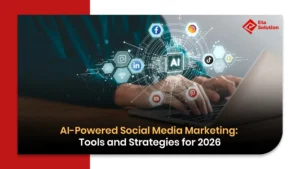
The Role of Image Alt Text in E-commerce SEO | Boost Product Visibility
When was the last time you searched for a product and went to the “Images” tab even before looking at the website? You’re not the only one. A 2024 Google survey shows that more than 27% of online shoppers start to discover products through image search results. So each image relating to your online store takes more impact than it seems, and the alt text of images is usually the factor that decides whether those pictures are found or not.
While marketers are discussing meta descriptions, product titles, or backlinks, still, many are still ignoring the invisible power that drives e-commerce SEO. Nonetheless, alt text is one of the most dependable and least utilized ways to bring visibility, accessibility, and conversions.
1. What Is Image Alt Text?
Alt text is the detailed information about the image that is provided in the HTML code of the image. It describes the image to search engines so that people who use screen readers or have slow internet connections can also get the visual context.
On the web, where visuals are the keys to decisions, alt text is not only a technological requisite but also a content marketing asset that links your product images to the relevant queries. If done right, it will make sense to both the humans and the search engines.
2. Importance of Alt Text for SEO
Search engines that can’t “see” images like people do have to rely on image description to get the idea of the image content. Without the alt text, your images are almost out of sight for the search engine robots.
A nicely written alt text is:
- Improves crawlability: The search machines use it to figure out the relevance and context of the image.
- Raise keyword association: It links the images with the target words for SEO best practices.
- Facilitates accessibility: It is a necessary part of web accessibility, being the reason why the site is usable for people with visual impairments.
Interestingly, Google’s 2025 Image Search algorithm update provided 10-15% more weight to images with optimized alt text, especially for e-commerce websites.
3. How Alt Text Improves E-commerce Product Visibility
Every online brand wants its products to be more visible, but only a handful of them understand that image-based searches are usually a buyer’s first contact point.
The alt text association is just as follows:
- Search Intent Matching: Properly written alt product text will be able to match it with the most appropriate user search queries.
- Rich Snippets and Featured Images: Images that are optimized can be found in Google’s visual packs, which are currently the most visible part of mobile phones.
- Improved Conversion Paths: It becomes a buyer’s journey, a significant SEO for online store performance, when image search results direct link to product pages, thus turning the route short.
4. Best Practices for Writing Effective Alt Text
Effective alt text needs to feature just the right amount of clarity, brevity, and relevance. You will find the following ways helpful in completing your mission.
- Be one descriptive but brief: depict the photo in the simplest way possible using fewer than 125 characters.
Example: “Women’s blue running shoes with cushioned soles.”
- Use keyword phrases naturally: Do not stuff. Combine the terms where they fit.
- Do not use generic words: Avoid using terms like “image of” or “photo of”. Simply name the object or the action without any detour.
- The importance of context: Adapt your description depending on whether the image is a banner, gallery, or thumbnail.
Soc ASOS and Zappos have been using descriptive alt text as one of the pillars of their image SEO strategy for a long time, which not only helps them to be found by traditional but also by image-based product searches.
5. Common Mistakes to Avoid in Alt Text
Even professional marketers make the same errors:
- Keyword Stuffing: Google treats repetitive or forcibly written alt texts as manipulative content.
- Missing context: The phrase “red shirt”, if used for every variant of product, won’t help differentiate by fabric, fit, or occasion.
- Blank tags: Not filling alt attributes is like throwing away indexing potential.
- Over-description: Overloading with taglines or e-commerce marketing phrases dampens the usefulness of alt text.
These types of mistakes may lower your ranking in the search engine and cause your product images to become less helpful for customers who rely on assistive technologies.
6. Alt Text and Accessibility Compliance
Alt text is not simply about SEO but rather website accessibility and compliance. The Web Content Accessibility Guidelines (WCAG) clearly state that non-negotiable accessible images are a must-have for online businesses.
In 2024, there were more than 2,300 U.S. companies that were sued over accessibility issues, with a significant number of cases related to missing alt text on product images. Besides the legal hazards, it is a matter of ensuring that no customer is left out and that they can all use your store, no matter their capabilities.
One of the easiest ways to show that your brand is responsible and still reap e-commerce SEO benefits is by adding alt text to your product images.
7. Optimizing Alt Text for Keywords
This is the spot where the precision meets the purpose. The integration of keywords in the alt text helps images rank for the targeted queries, but the key is the balance.
- Employ long-tail keywords that depict the buyer’s intent.
- Incorporate semantic variations to cover search diversity.
- Match keywords to page-level content for contextual consistency.
Leading Ecommerce marketing agency India uses tools like Ahrefs and Google Lens Trends to map keyword opportunities for alt text, a tactic that’s driving measurable visibility spikes in competitive niches like apparel and beauty.
8. Role of Alt Text in Image Search Rankings
Alt text directly influences image optimization and ranking potential. With visual searches growing 30% year-over-year, search engines now prioritize images that combine:
- Relevant file names
- Optimized alt attributes
- Fast-loading formats
Brands investing in structured image metadata have seen up to 20% higher impressions on Google Images. A good example is IKEA, which uses descriptive alt text across every catalog image, linking visual inventory to category-level keywords, significantly improving product discoverability.
9. Tools to Analyze and Optimize Alt Text
Modern marketers rely on tools to audit and refine alt text quality. Some top performers include:
- Screaming Frog SEO Spider: This tool will crawl your website to find duplicate or missing alt text.
- Ahrefs Site Audit: Serves as a keyword target and its relatedness measurement.
- Google Lighthouse: Find accessibility and performance issues.
- ImageKit and TinyPNG: Are technical support tools for images that facilitate faster loading of the website.
Agencies like leading Ecommerce marketing agency India use such audit stacks to ensure every product image contributes to organic traffic instead of being an idle asset.
10. Case Studies: Alt Text Impact on E-commerce SEO
A fashion retailer in the U.S. saw a 37% rise in organic image clicks within 60 days after rewriting alt text for 2,000 product images. Similarly, a global furniture brand improved conversion rates by 12% after optimizing visual metadata, proving that visuals are not just aesthetic, they’re strategic.
During a Search Marketing Expo (SMX) session in 2025, Google’s Senior Webmaster Analyst highlighted that brands maintaining “semantic integrity” between product titles, descriptions, and alt text consistently outperform competitors in search engine ranking.
Even the top Ecommerce marketing agency India teams confirm: alt text optimization is no longer an optional checkbox; it’s a differentiator in competitive markets.
Closing Thoughts
Alt text is not only a way to satisfy the algorithms, but also to create a complete digital experience that is the product of the combination of visibility, accessibility, and performance. The higher the competition in the e-commerce industry, the more likely it is that the last-minute details, like the words behind your images which can change your position in the search.
So, the question for marketers and e-commerce leaders is: Are your visuals merely seen, or are they truly searchable?
When search engines crawl your website, they can’t “see” images — they read the alt text to understand what the image depicts. Adding relevant keywords naturally in your alt text helps search engines associate your products with specific search queries, improving your product visibility and organic ranking in image and web searches.
Use clear and descriptive language that explains what the image shows.
Include primary keywords naturally without stuffing.
Avoid using generic terms like “image” or “photo.”
Keep it short and relevant (under 125 characters if possible).
Make sure each product image has unique alt text to prevent duplication.
Yes. Alt text ensures that people using screen readers can understand your product visuals through text descriptions. This makes your online store more inclusive and user-friendly, while also meeting accessibility standards like WCAG (Web Content Accessibility Guidelines).
Most e-commerce platforms like Shopify, WooCommerce, and Magento allow you to add alt text directly in the image settings or media library. Simply edit your product image, locate the “Alt Text” or “Alternative Text” field, and enter a short, descriptive sentence that reflects the image content and keywords.
Keyword stuffing — forcing too many keywords can harm SEO.
Leaving alt text blank — this wastes SEO potential.
Duplicating alt text across multiple images.
Being vague or generic — “product image” or “photo” doesn’t add value.
Ignoring accessibility — alt text should make sense to human readers, not just search engines.

What started as a passion for marketing years ago turned into a purposeful journey of helping businesses communicate in a way that truly connects. I’m Heta Dave, the Founder & CEO of Eta Marketing Solution! With a sharp focus on strategy and human-first marketing, I closely work with brands to help them stand out of the crowd and create something that lasts, not just in visibility, but in impact!

Industrial Product Marketing with LinkedIn & Paid Ads

Top Digital Marketing Strategies for Industrial Products in 2026

B2B Product Launch Strategies: From Pre-Launch to Go-To-Market

